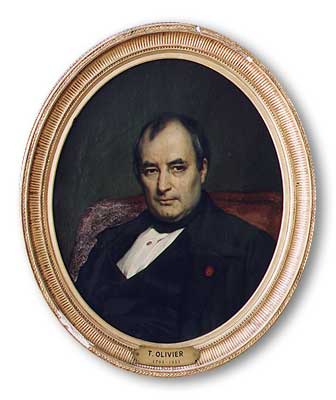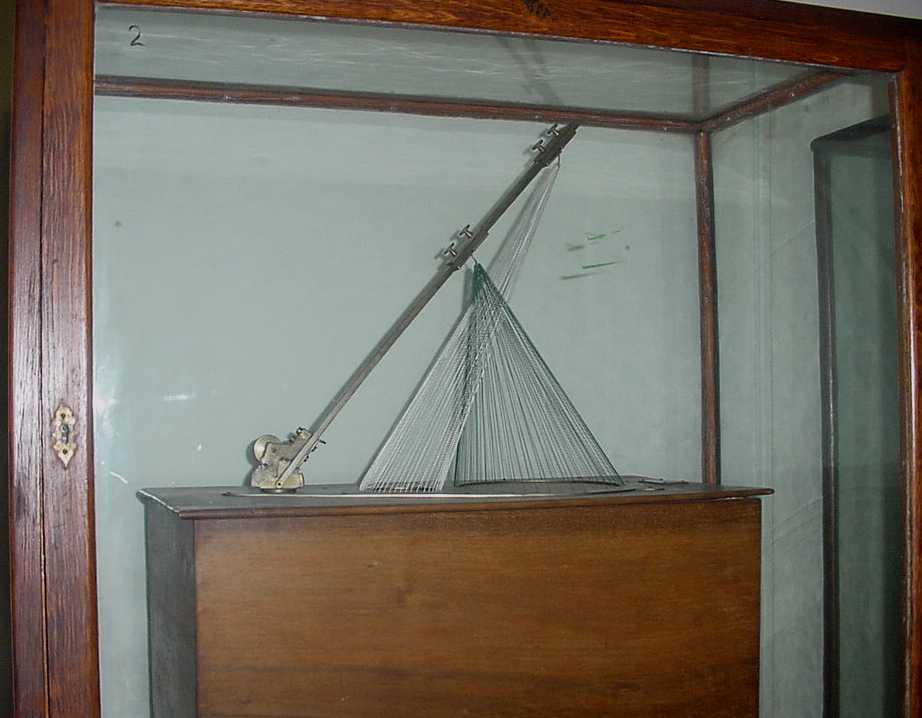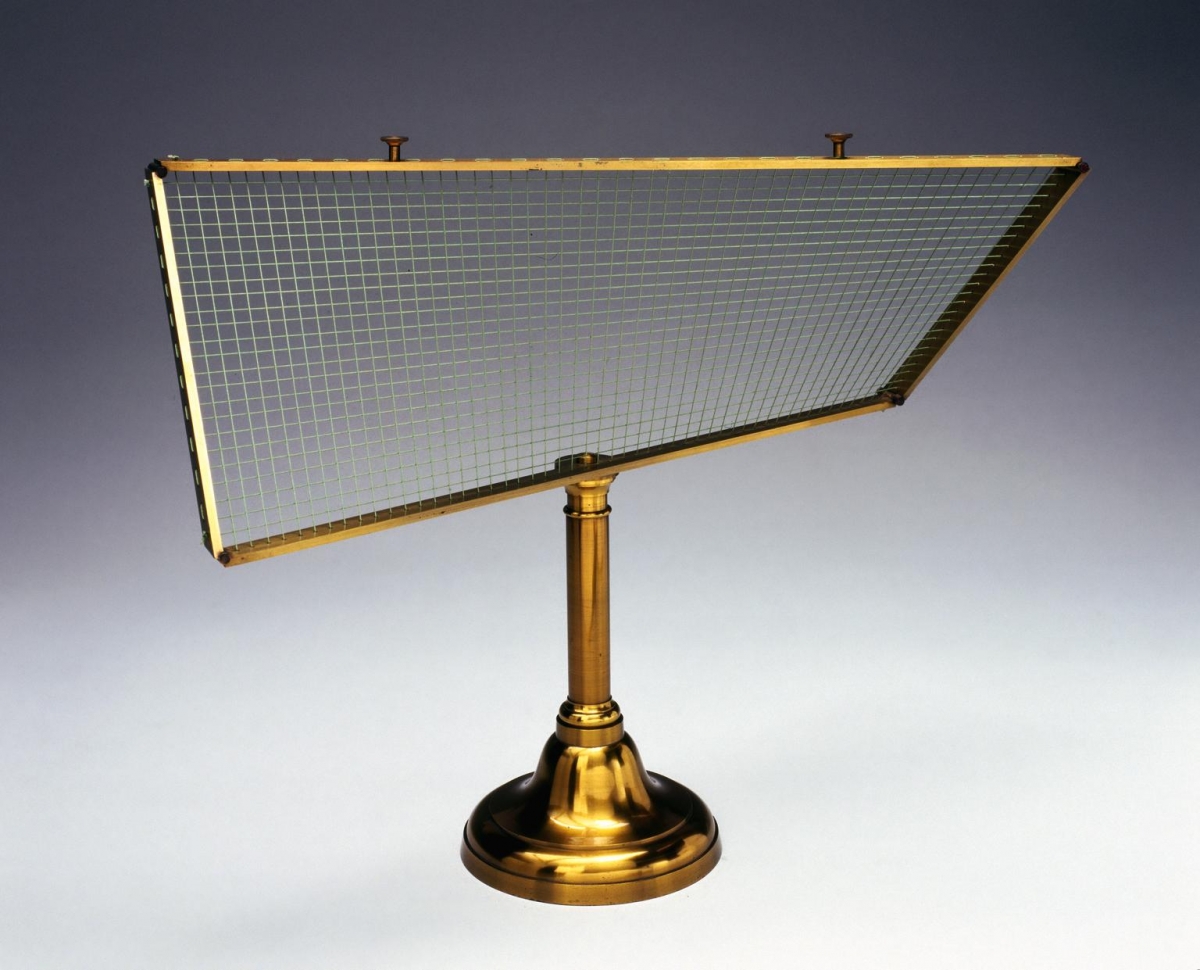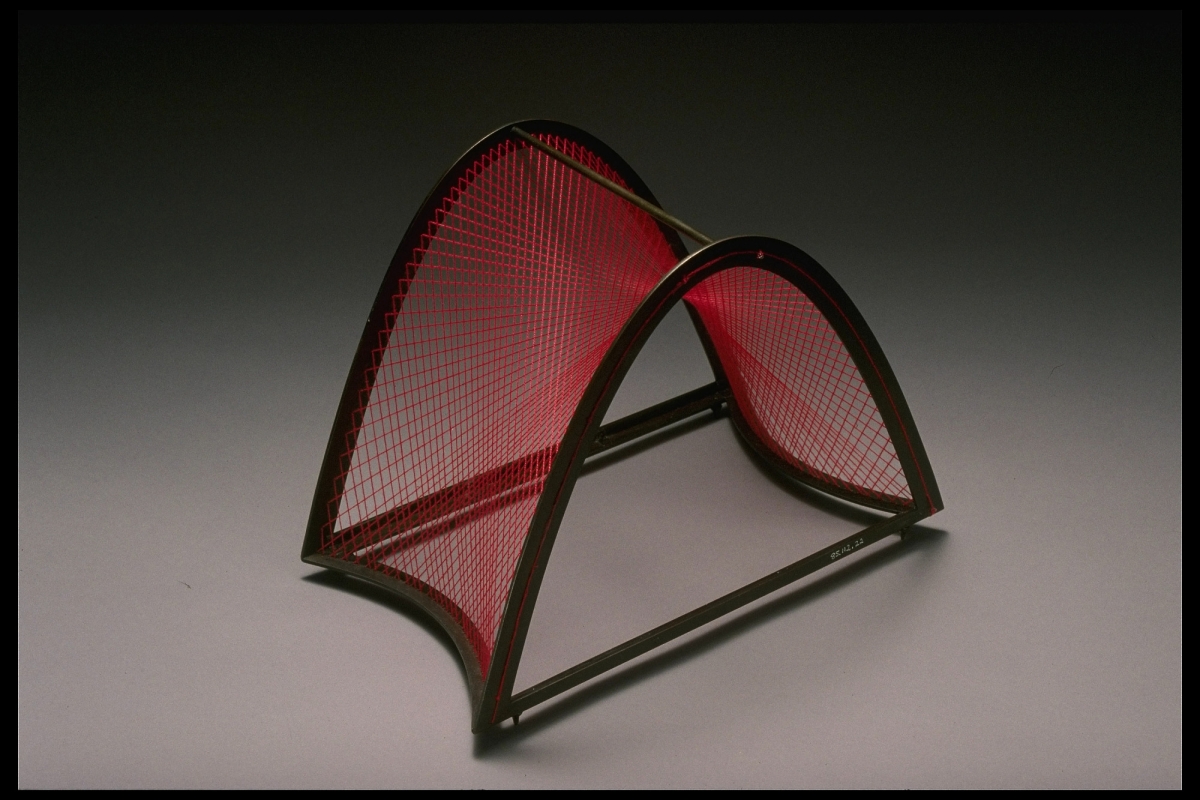Keys to Mathematical Treasure Chests: 19th-century String Models
Roughly forty years ago, a young mathematician teaching about three-dimensional surfaces in a course at Amherst College in Massachusetts laboriously drew an image on the blackboard. A student inquired if the figure represented the same surface as a plaster model sitting in a case at the back of the classroom—part of a group of models the instructor had never carefully examined. It did.

Figure 1. Display case of mathematical objects such as the Amherst student might have noticed.
Assembled at the University of Arizona, ca 1998.
This revelation did not inspire either the student or the mathematician to study the models carefully. However, this anecdote reminds us that Amherst is not the only institution to have invested in models and other teaching apparatus in earlier days. Whether such objects would still assist in teaching specific mathematical topics, I cannot say. They do offer a way to better understand mathematical pedagogy, communities within mathematics, and connections between mathematics and such other disciplines as engineering and the visual arts.
Collections of mathematical instruments in museums, universities, and schools can include general teaching devices from the slate and blackboard to graph paper to the white board. They may comprise digital tools for carrying out arithmetic operations, such as the abacus, adding and calculating machines, and cash registers. Analog computing devices ranging from astrolabes to drawing instruments of various sorts to slide rules may also be found in collections. However, mathematicians intrigued by objects probably puzzle most often over various sorts of mathematical models. As stated above, these objects—made from plaster, wood, metal, string, or plastic—adorn the halls of some mathematics buildings and, sometimes, classrooms. Some of these were purchased from afar, some were constructed locally. Most have been produced by human handiwork, but three-dimensional printing now plays a role. In what follows, I shall describe chronologically one tradition in making models of surfaces that emerged in 19th-century French engineering, was continued by mathematical model makers in Germany and elsewhere, and even influenced the development of string sculpture by Henry Moore and others. There already are fine historical accounts of much of this work—as is the raison d’etre of this series, my emphasis will be on a few databases that allow one to see the stuff . . . or at least images of it!
Keys to Mathematical Treasure Chests: 19th-century String Models – The String Models of Théodore Olivier, Hippolyte Pixii, and Fabre de Lagrange
In the early 19th century, with the rise in descriptive geometry in France under the influence of Gaspard Monge,[1] engineering students were encouraged to examine models, the better to improve their perspective drawings. While not the first geometric models made, these were among the first manufactured and sold for university teaching. More specifically, Théodore Olivier, a student of Monge who was a founding professor at the École Centrale des Arts et Manufactures in Paris, believed that it was important to make abstract mathematical ideas “applicable to terrestrial things” [quoted in Xavier and Pinho 2017, 402]. One way to do this was by embodying them in physical models. In 1829 Olivier designed a relatively simple model for teaching descriptive geometry. Called the “omnibus,” it was a three-dimensional representation of geometric systems composed of line segments, points, and planes so that they could be projected onto a folding cork board. Such a model resembles those by Jullien in Paris later in the century (on Jullien models, see below). According to Xavier and Pinho [2017, 401–402], such models sold widely in Portuguese technical schools at least as late as the 1890s.

Figure 2. Théodore Olivier (1793–1853). Public domain.
Beginning in the 1830s, Olivier designed several elegant string models with brass frames that were manufactured by the instrument maker Hippolyte Pixii and the firm that succeeded his enterprise, Fabre de Lagrange, both of Paris. These ruled surfaces often were designed to be moveable, the better to illustrate engineering problems. Like the omnibus, they were intended for demonstration to groups of students (rather than manipulation by individuals). Such models apparently were not universally welcomed—according to Olivier, they were even outlawed for a time. However, by the mid-19th century such prohibitions had passed [Xavier and Pinho 2017, 402]. Olivier models spread across Europe and the United States, and would be used at some engineering schools for decades.
Examples of Olivier models were acquired by the Conservatoire des Arts et Métiers (CNAM) in Paris in 1849. These have been catalogued in detail, although not quite all have been photographed.
 To find the Olivier models at the CNAM, go to the main collections database page Collections | Musée des Arts et Metiers (arts-et-metiers.net) and search for "Pixii Père et Fils." Those associated with Olivier have his name listed as well (Olivier’s name is also associated with several other engineering models, so searching for his name is not as useful). There are several ways to view the resulting set of records. Clicking on the title of an object brings up more detailed information.
To find the Olivier models at the CNAM, go to the main collections database page Collections | Musée des Arts et Metiers (arts-et-metiers.net) and search for "Pixii Père et Fils." Those associated with Olivier have his name listed as well (Olivier’s name is also associated with several other engineering models, so searching for his name is not as useful). There are several ways to view the resulting set of records. Clicking on the title of an object brings up more detailed information.
William M. Gillespie, professor of civil engineering at Union College in Schenectady, New York, purchased a set of models from Olivier’s widow in about 1855 and used them in his teaching. These were acquired by the college itself after Gillespie’s death in 1868. In 1995, the models were transferred to the permanent collections of the Mandeville Gallery at Union; eleven of them may be seen on that institution’s website.[2]
The U.S. Military Academy at West Point (USMA) and Harvard University purchased examples of Olivier models in 1857. Historian of mathematics Fred Rickey, an emeritus professor of the USMA, has recorded information about models there and in related collections, making note of the rich historical literature.[3] A few remaining examples from Harvard are in the database of that collection.
 For information about the West Point Olivier models, see Catalogue of Olivier Models (fredrickey.info). For further information Fred Rickey has compiled, see OlivierModels (fredrickey.info). The Harvard models are shown at Results | Search Objects | The Collection of Historical Scientific Instruments (harvard.edu). The general website for searching the collection is The Collection of Historical Scientific Instruments (harvard.edu).
For information about the West Point Olivier models, see Catalogue of Olivier Models (fredrickey.info). For further information Fred Rickey has compiled, see OlivierModels (fredrickey.info). The Harvard models are shown at Results | Search Objects | The Collection of Historical Scientific Instruments (harvard.edu). The general website for searching the collection is The Collection of Historical Scientific Instruments (harvard.edu).

Figure 3. West Point Olivier model depicting the intersection of two cones. Photographed by Amy Shell-Gellasch
ca 2001 and accessed via the Wayback Machine.
Olivier models also attracted attention in Mississippi. Eisso J. Atzema and Gerard Buskes [2009] report that by 1857 Frederick A .P. Barnard asked German immigrant Ferdinand Engel if he might make copies of the Olivier models for the collections he was building at the University of Mississippi. Apparently these do not survive with other materials Barnard collected that are at the University of Mississippi Museum—Atzema and Buskes speculate that Barnard might have taken the models with him when he moved to Columbia University in New York at the time of the American Civil War. Rickey has noted evidence that Columbia indeed did once have such models. As F. C. Moon [2016] and others have mentioned, Cornell University had copies of the Union College Olivier models made locally in the 1860s. Some of these survive, and a few are still on exhibition at Cornell. According to William Stone [1969], Princeton University reportedly ordered copies of these surfaces around 1882, although I have not found evidence that these survive nor do I know who made them.
European technical schools outside of France also took an interest in models for descriptive geometry on Olivier’s design. For example, the Escola Politénica de Lisboa in Lisbon, Portugal, acquired a set from Pixii’s successor, Fabre de Lagrange, in 1861. Not to be outdone, the Instituto Superiur de Engenharia do Porto (ISEP, also in Portugal in the city of Porto) acquired copies of Olivier models made by Sécretan of Paris in 1868 [Xavier and Pinho 2017, 410]. Some twenty-seven of this second group of models survive at the Museum of the ISEP and may be viewed on its database: MUSEU ISEP - Base de Dados (ipp.pt).
 For photographs of an exhibit of some of the Sécretan models for descriptive geometry at the ISEP, see MUSEU ISEP - Abril (ipp.pt). For images of a larger portion of the models, see Modelos (aproged.net). The database of the ISEP Museum, which includes all the models, is at MUSEU ISEP - Base de Dados (ipp.pt). Patricia Costa of that museum gives instructions for use of this database as follows: “Click on ‘entrar como convidado’ (enter as guest), next click on ‘pesquisa’ (search), then write ‘Modelo de geometria descritiva’ (descriptive geometry model) and you can see a list with all of the collection. The information about the models is available only in Portuguese.” Clicking on an item in the list brings up a description and image. Clicking on an image enlarges it. An arrow at the bottom of an individual object record moves one on to the next object record.
For photographs of an exhibit of some of the Sécretan models for descriptive geometry at the ISEP, see MUSEU ISEP - Abril (ipp.pt). For images of a larger portion of the models, see Modelos (aproged.net). The database of the ISEP Museum, which includes all the models, is at MUSEU ISEP - Base de Dados (ipp.pt). Patricia Costa of that museum gives instructions for use of this database as follows: “Click on ‘entrar como convidado’ (enter as guest), next click on ‘pesquisa’ (search), then write ‘Modelo de geometria descritiva’ (descriptive geometry model) and you can see a list with all of the collection. The information about the models is available only in Portuguese.” Clicking on an item in the list brings up a description and image. Clicking on an image enlarges it. An arrow at the bottom of an individual object record moves one on to the next object record.

Figure 4. Olivier model of a hyperbolic paraboloid made by Fabre de Lagrange in 1872. Science Museum object number 1872-96, made available via Creative Commons Attribution-NonCommercial-ShareAlike 4.0 Licence.
The Science Museum in London acquired a set of Olivier-style models made by Fabre de Lagrange in 1872. About a century later, the institution transferred part of this acquisition to the Canadian Museum of Science and Technology (now part of the Ingenium) in Ottawa.[4] Models from this acquisition may be seen at both museums’ websites.
 For those in the Science Museum collections, see Fabre de Lagrange | Science Museum Group Collection. For those at the Ingenium, see Collection Online (Beta) - Ingenium (ingeniumcanada.org) and search for “Lagrange.” The results may be found at Collection Online (Beta) - Ingenium (ingeniumcanada.org). Clicking on the name of an object brings up descriptions. At this writing, there are no photographs.
For those in the Science Museum collections, see Fabre de Lagrange | Science Museum Group Collection. For those at the Ingenium, see Collection Online (Beta) - Ingenium (ingeniumcanada.org) and search for “Lagrange.” The results may be found at Collection Online (Beta) - Ingenium (ingeniumcanada.org). Clicking on the name of an object brings up descriptions. At this writing, there are no photographs.
Curator Barry Phipps and colleagues mounted an exhibit in 2012 that explored connections between the Science Museum models and string sculpture, particularly that of Henry Moore; it appeared jointly at the Science Museum and at the Royal Society of London. A copy of the elegantly illustrated exhibit catalog is available online [Phipps et al. 2012].
By the late 19th century, smaller, less elegant, but less expensive models for descriptive geometry—more like Olivier’s original omnibus—were available. One such set, made in the mid-1870s on the design of the Parisian textbook author A. Jullien, is in the Smithsonian collections and has been catalogued in detail by Amy Shell-Gellasch: https://americanhistory.si.edu/collections/object-groups/geometric-models-jullien-models-for-descriptive-geometry. (This object is also a Convergence Mathematical Treasure.)
[1] For a discussion of the international diffusion of the teaching of descriptive geometry and the founding of diverse polytechnic schools, see [Barbin et al. 2019]. The volume focuses on textbooks and educational institutions, not models.
[2] For an account of the history of the Olivier models at Union, see Castrucci Gallery: Olivier Models at Union College | Mandeville Gallery. A useful published introduction to these and other Olivier models is [Stone 1969].
[3] Print publications on the USMA Olivier models include [Shell-Gellasch 2003] and [Acheson 2007].
[4] For a discussion of Olivier models, particularly those that ended up in Canada, see [Pantalony 2017, esp. pp. 263–265].
Keys to Mathematical Treasure Chests: 19th-century String Models – Later Makers of String Models
The relatively simple paper models made by Jullien generally show the projection of a few line segments onto perpendicular planes. Some model makers continued the tradition of making more elaborate ruled surfaces, although they generally described them as mathematical (rather than engineering) models. Those distributed most widely were made and sold by the Germans Ludwig Brill and his successor Martin Schilling. Examples of these survive in collections across the world. About twenty are in the Smithsonian’s National Museum of American History (NMAH), most from a collection of Brill models exhibited at the World’s Fair held in Chicago in 1893. Brill's successor, Martin Schilling, would continue to sell these models well into the 20th century.
 For examples of Brill models of ruled surfaces in the Smithsonian collections, see https://americanhistory.si.edu/collections/search?return_all=1&edan_local=1&edan_q=Brill%20%22ruled%20surface%22%20metal%20Wesleyan. This chest has an extra treasure!
For examples of Brill models of ruled surfaces in the Smithsonian collections, see https://americanhistory.si.edu/collections/search?return_all=1&edan_local=1&edan_q=Brill%20%22ruled%20surface%22%20metal%20Wesleyan. This chest has an extra treasure!

Figure 5. Brill’s model of a hyperbolic paraboloid, 1892. Smithsonian Institution negative number NMAH-97-9530.
American model makers such as the firm of Eberbach in Ann Arbor, Michigan, and University of Iowa professor Richard P. Baker made similar models in the late 19th and early 20th centuries—examples of these also survive at the Smithsonian and, in Baker’s case, at the University of Arizona. Baker distributed his models into the 1930s.
 For two Eberbach models of ruled surfaces, see https://americanhistory.si.edu/collections/search/object/nmah_1213977 and https://americanhistory.si.edu/collections/search/object/nmah_1196291. Two related, unsigned models from the University of Michigan are https://americanhistory.si.edu/collections/search/object/nmah_1213978 and https://americanhistory.si.edu/collections/search/object/nmah_213480.
For two Eberbach models of ruled surfaces, see https://americanhistory.si.edu/collections/search/object/nmah_1213977 and https://americanhistory.si.edu/collections/search/object/nmah_1196291. Two related, unsigned models from the University of Michigan are https://americanhistory.si.edu/collections/search/object/nmah_1213978 and https://americanhistory.si.edu/collections/search/object/nmah_213480.
 For Baker’s string models of ruled surfaces, see https://americanhistory.si.edu/collections/search?return_all=1&edan_local=1&edan_q=Baker%20ruled%20surface&. Examples of Baker models of ruled surfaces are also found at the University of Arizona. See Mathematical Models at the University of Arizona, particularly under “Ruled surfaces.” Not all of the ruled surfaces shown at this address are by Baker.
For Baker’s string models of ruled surfaces, see https://americanhistory.si.edu/collections/search?return_all=1&edan_local=1&edan_q=Baker%20ruled%20surface&. Examples of Baker models of ruled surfaces are also found at the University of Arizona. See Mathematical Models at the University of Arizona, particularly under “Ruled surfaces.” Not all of the ruled surfaces shown at this address are by Baker.
Keys to Mathematical Treasure Chests: 19th-century String Models – Conclusion and References
Conclusion
In the mid-20th century, the focus of mathematical research and instruction moved away from the relatively simple surfaces represented by models. Engineering schools also found models of less use to their instructional purposes. Indeed, by the end of the century, computer graphics had replaced much of physical modelling. Nonetheless, as the case of models for descriptive geometry well illustrates, a rich array of mathematical treasures are now available not only through written texts but through diverse—and expanding—databases.
References
Acheson, Bill. 2007. “Geometric String Models of Descriptive Geometry.” In Hands on History, edited by Amy Shell-Gellasch, 49–62. Washington, DC: MAA.
Atzema, Eisso J., and Gerard Buskes. 2009. “‘Engel’s Ingenious Models’: on the Models of the Fresnel Wave Surface at the University of Mississippi.” Rittenhouse 22(1): 90–122.
Barbin, Evelyne, Marta Menghini, and Klaus Volkert, eds. 2019. Descriptive Geometry, the Spread of a Polytechnic Art: The Legacy of Gaspard Monge. Cham, Switzerland: Springer.
Moon, Francis C., and John F. Abel. 2016. “19th c. Olivier String Models at Cornell University: Ruled Surfaces in Gear Design.” In Explorations in the History of Machines and Mechanisms, edited by C. López-Cajún and M. Ceccarelli, 195–207. Cham: Springer.
Pantalony, David. 2017. “Collectors Displays and Replicas in Context: What We Can Learn from Provenance Research in Science Museums.” In The Romance of Science: Essays in Honour of Trevor H. Levere, edited by Jed Buchwald and Larry Stewart, 257–275. Cham: Springer.
Phipps, Barry et al. 2012. Intersections: Henry Moore and Stringed Surfaces. London: Royal Society of London.
Shell-Gellasch, Amy. 2003. “The Olivier Models at West Point.” Rittenhouse 17(2): 71–84.
Stone, William C. 1969. The Olivier Models. Schenectady, NY: Friends of the Union College Library.
Xavier, J. P., and E. M. Pinho. 2017. “Olivier String Models and the Teaching of Descriptive Geometry,” In Dig Where You Stand. Proceedings of the Fourth International Conference on the History of Mathematics Education, edited by K. Bjarnadóttir, F. Furinghetti, M. Menghini, J. Prytz, and G. Schubring, 399–414. Rome: Edizioni Nuova Cultura.
Collections
Catalogue of Olivier Models, Frederick V. Rickey, United States Military Academy (emeritus).
Conservatoire des Arts et Métiers Collections, Musée des Arts et Metiers, Paris, FR.
Ingenium Collection Online (Beta), Canadian Museums of Science and Innovation, Ottawa, ON.
Mathematical Models Collection, Department of Mathematics, University of Arizona, Tucson, AZ.
MUSEU ISEP Collections, Museu do Instituto Superior de Engenharia do Porto, Porto, Portugal.
National Museum of American History Collections, Smithsonian Institution, Washington, DC.
Science Museum Group Collection, Science Museum of London, London, UK.
The Collection of Historical Scientific Instruments, Harvard University, Cambridge, MA.
Acknowledgements
Historians of mathematics and museum staff who have assisted in searching specific collections are generally mentioned in the text. I thank them as well as Smithsonian colleagues, especially Judy Green and Rhoda Ratner, for their work with Smithsonian examples of the models. Finally, I am most grateful to those associated with Convergence for numerous improvements to the article.
About the Author
After undergraduate work in physics and graduate study in the history of science, Peggy Aldrich Kidwell became a postdoctoral fellow at NMAH. She then began working in the mathematics collections, curating materials ranging from an 11th-century astrolabe to a 21st-century whiteboard. She and colleagues have written numerous articles and books on the history of mathematical instruments and computers and prepared diverse exhibits showcasing these artifacts. They also have spent much of the past decade preparing online accounts of objects.